Steatite Powder Additives in Wood-Cement Drywall Particleboards
Abstract
1. Introduction
2. Materials and Methods
2.1. Material
2.2. Material Characterisation
2.2.1. Wood Particles
2.2.2. Steatite Powder
Chemical Composition
Particle Size Analysis
Material Preparation
2.3. Test Methods
2.4. Preliminary Work
3. Results
3.1. Change in Density
3.2. Scanning Electron Microscopy
3.3. Bending Properties
3.4. Screw Withdrawal and Nail Pull Test
3.5. Water Absorption
3.6. Thermal Properties
3.7. Reaction to Fire
4. Conclusions
Author Contributions
Funding
Acknowledgments
Conflicts of Interest
References
- Hobart, M.K. Soapstone What is Soapstone? How does it Form? How is it Used? Geoscience New and Information. Available online: https://geology.com/rocks/soapstone.shtml (accessed on 30 April 2020).
- Sudalaimani, K.; Shanmugasundaram, M. Influence of Ultrafine Natural Steatite Powder on Setting Time and Strength Development of Cement. Adv. Mater. Sci. Eng. 2014, 2014, 532746. [Google Scholar] [CrossRef]
- Anonymous. Talc, Soapstone and Steatite in Indian Minerals Yearbook; Government of India, Ministry of Mines, Indian Bureau of Mines: Nagpur, India, 2013.
- Ramirez-Coretti, A.; Eckelman, C.; Wolfe, R. Inorganic-bonded composite wood panel systems for low-cost housing: A Central American perspective. Forest Prod. J. 1998, 48, 62–68. [Google Scholar]
- Berger, F.; Gauvin, F.; Brouwers, H.J.H. The recycling potential of wood waste into wood-wool/cement composite. Constr. Build. Mater. 2020, 260, 119786. [Google Scholar] [CrossRef]
- Tittelein, P.; Cloutier, A.; Bissonnette, B. Design of a low-density wood–cement particleboard for interior wall finish. Cem. Concr. Compos. 2012, 34, 218–222. [Google Scholar] [CrossRef]
- Němec, M.; Igaz, R.; Gerge, T.; Danihelová, A.; Ondrejka, V.; Krišťák, L.; Gejdoš, M.; Kminiak, R. Acoustic and thermophysical properties of insulation materials based on wood wool. Akustika 2019, 33, 115–123. [Google Scholar]
- Govin, A.; Peschard, A.; Guyonnet, R. Modification of cement hydration at early ages by natural and heated wood. Cem. Concr. Compos. 2006, 28, 12–20. [Google Scholar] [CrossRef]
- Panzera, T.; Hallak, T. Cement-steatite composites reinforced with carbon fibres: An alternative for restoration of brazilian historical buildings. Mater. Res. 2011, 14, 118–123. [Google Scholar] [CrossRef]
- Mahsa, K.; Ali, G. Effect of glass powders on the mechanical and durability properties of cementitious materials. Constr. Build. Mater. 2015, 98, 407–416. [Google Scholar]
- Vu, V.-A.; Cloutier, A.; Bissonnette, B.; Blanchet, P.; Duchesne, J. The effect of wood ash as a partial cement replacement material for making wood-cement panels. Materials 2019, 17, 2766. [Google Scholar] [CrossRef] [PubMed]
- KumarK, P.; Sudalaimani, M.; Shanmugasundaram, K. An Investigation on Self-Compacting Concrete Using Ultrafine Natural Steatite Powder as Replacement to Cement. Adv. Mater. Sci. Eng. 2017, 6, 1–8. [Google Scholar] [CrossRef]
- Weber, B. Heat transfer mechanisms and models for a gypsum board exposed to fire. Int. J. Heat Mass Transf. 2012, 55, 1661–1678. [Google Scholar] [CrossRef]
- Anonymous. Gypsum Board for Walls and Ceilings; Gypsum Association: Dallas, TX, USA, 1980. [Google Scholar]
- Anonymous. Fire Safety Design in Buildings; Canadian Wood Council: Ottawa, ON, Canada, 1996.
- Cramer, S.; Friday, O.; White, R.; Sriprutkiat, G. Mechanical properties of gypsum board at elevated temperatures. In Proceedings of the Fire and Materials 2003: 8th International Conference, San Francisco, CA, USA, 27–28 January 2003. [Google Scholar]
- Blanchet, P. Gypsum Replacement Material—A Biobased Proposal. In Proceedings of the 3rd International Conference on Bio-Based Building Materials, Belfast, UK, 26–28 June 2019. [Google Scholar]
- ASTM C618. Standard Specification for Fly Ash and Raw or Calcined Natural Pozzolans for Use Portland Cement Concrete; American Standard Test of Materials; ASTM International: Montgomery, PA, USA, 2019. [Google Scholar]
- Baig, Z.; Mamat, O.; Mustapha, M.; Mumtaz, A.; Sarfraz, S.M. An efficient approach to address issues of graphene nanoplatelets (GNPs) incorporation in aluminium powders and their compaction behavior. Metal 2018, 8, 90. [Google Scholar] [CrossRef]
- ASTM C473. Standard Test Methods for Physical Testing of Gypsum Panel Products; American Standard Test of Materials; ASTM International: Montgomery, PA, USA, 2017. [Google Scholar]
- ASTMD1037. Standard Test Method for Evaluating the Properties of Wood-Base Fiber and Particle Panel Materials; American Standard Test of Materials; ASTM International: Montgomery, PA, USA, 2012. [Google Scholar]
- ISO 5660. Reaction-to-Fire Tests-Heat Release, Smoke Production and Mass Loss Rate-Part 1: Heat Release Rate (Cone Calorimeter Method) and Smoke Production Rate (Dynamic Measurement); International Organization for Standardization: Geneva, Switzerland, 2015. [Google Scholar]
- ASTM C518. Standard Test Method for Steady-State Thermal Transmission Properties by Means of the Heat Flow Meter Apparatus; American Standard Test of Materials; ASTM International: Montgomery, PA, USA, 2017. [Google Scholar]
- ASTM C1437. Standard Test Method for Flow of Hydraulic Cement Mortar; Standard Test Methods for Physical Testing of Gypsum Panel Products; ASTM International: Montgomery, PA, USA, 2020. [Google Scholar]
- CAN/ULC-S135-92. Standard Method of Test for Determination of Degrees of Combustibility of Building Materials Using an Oxygen Consumption Calorimeter (Cone Calorimeter); Standards Council of Canada: Ottawa, ON, Canada, 1998. [Google Scholar]
- Mehaffey, J.; Dagenais, C. Assessing the Flammability of Mass Timber Components: A Review; FPInnovations: Pointe-Claire, QC, Canada, 2014. [Google Scholar]
- Mehaffey, J.R. Fire Performance of Interior Finishes, Room Linings and Structural Panel Products; Project Report No. 3638; Forintek Canada Corp: Ottawa, ON, Canada, 2006. [Google Scholar]
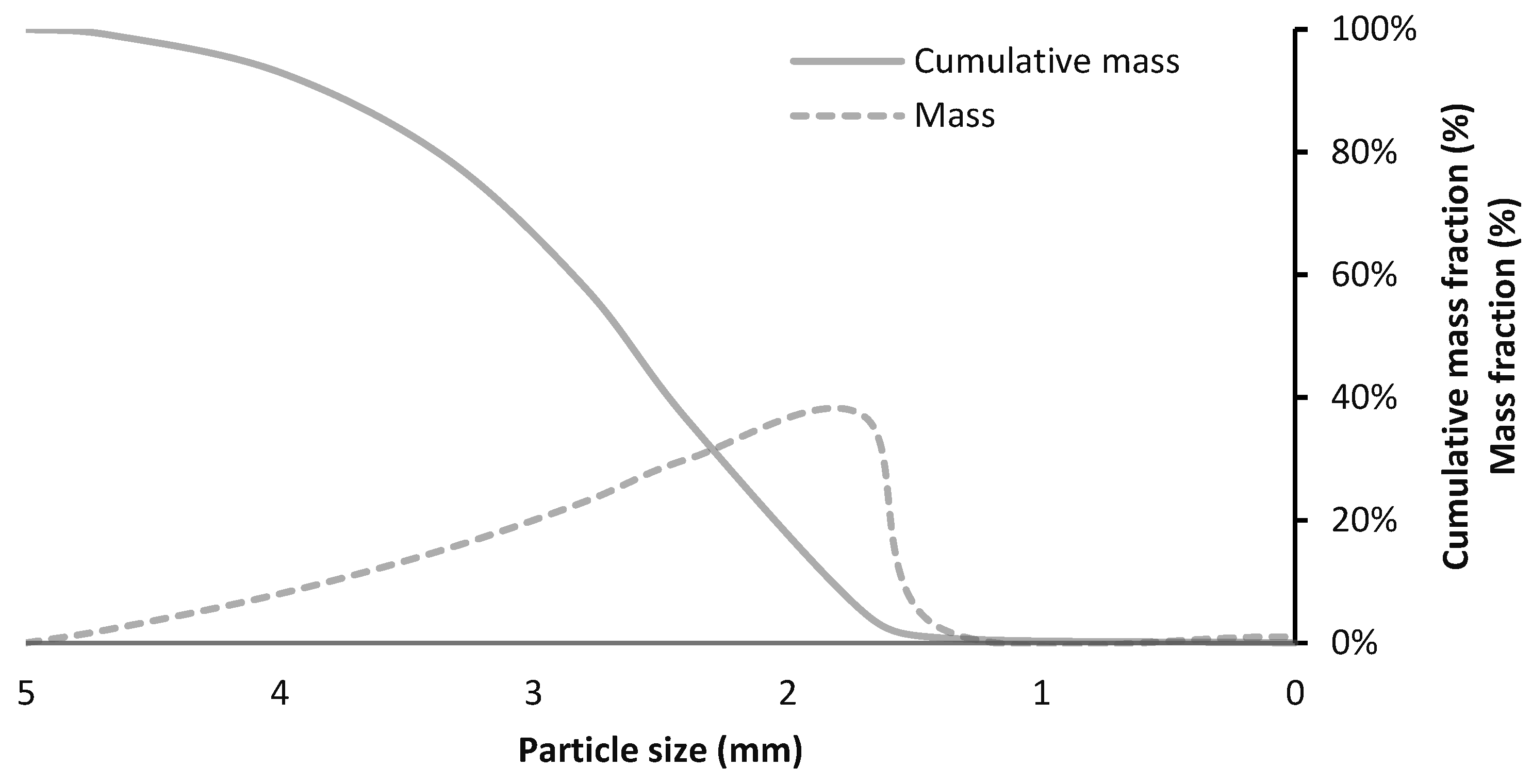
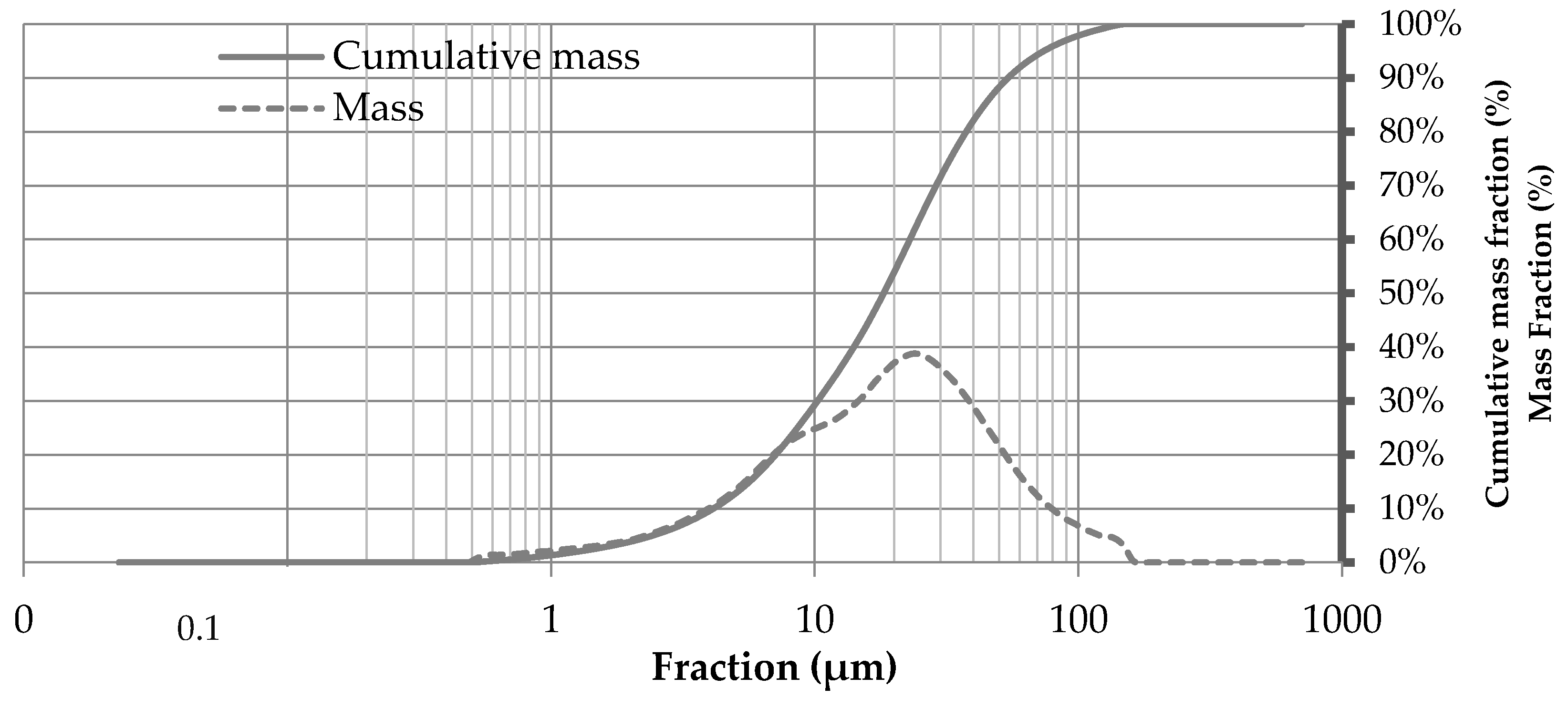
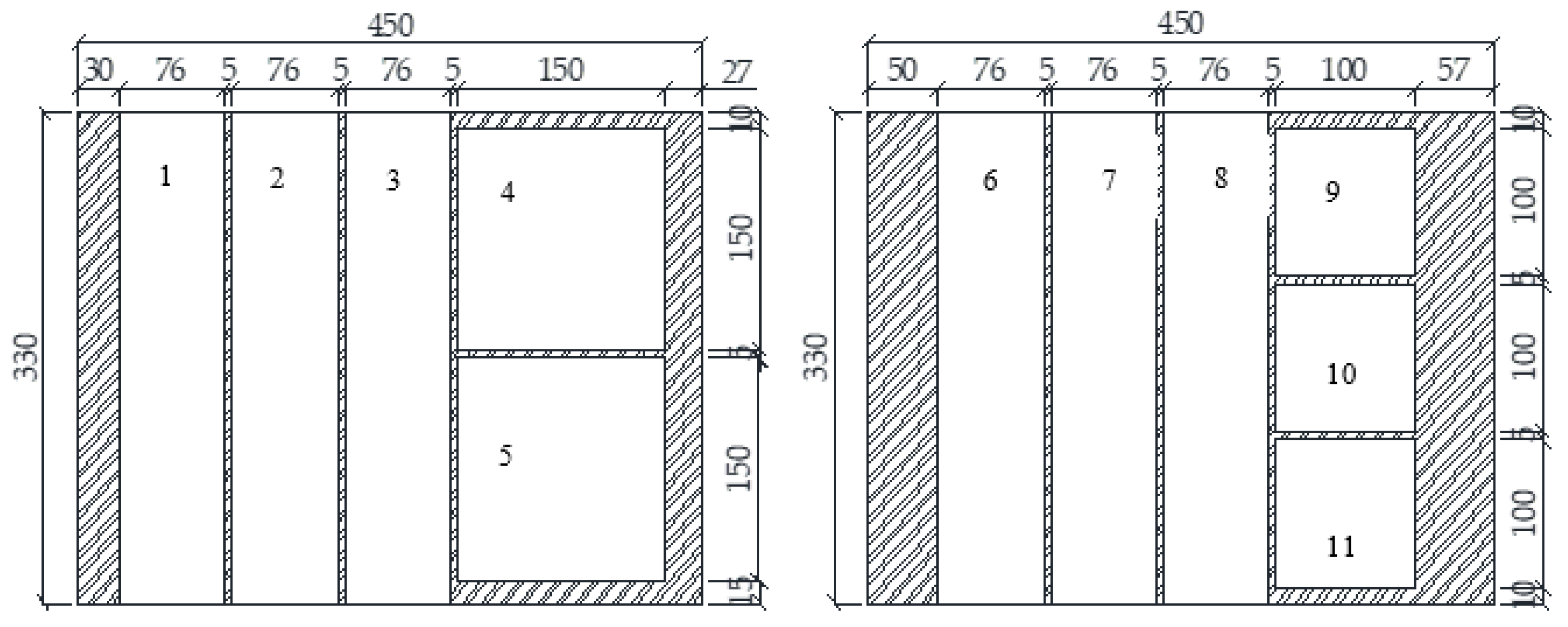
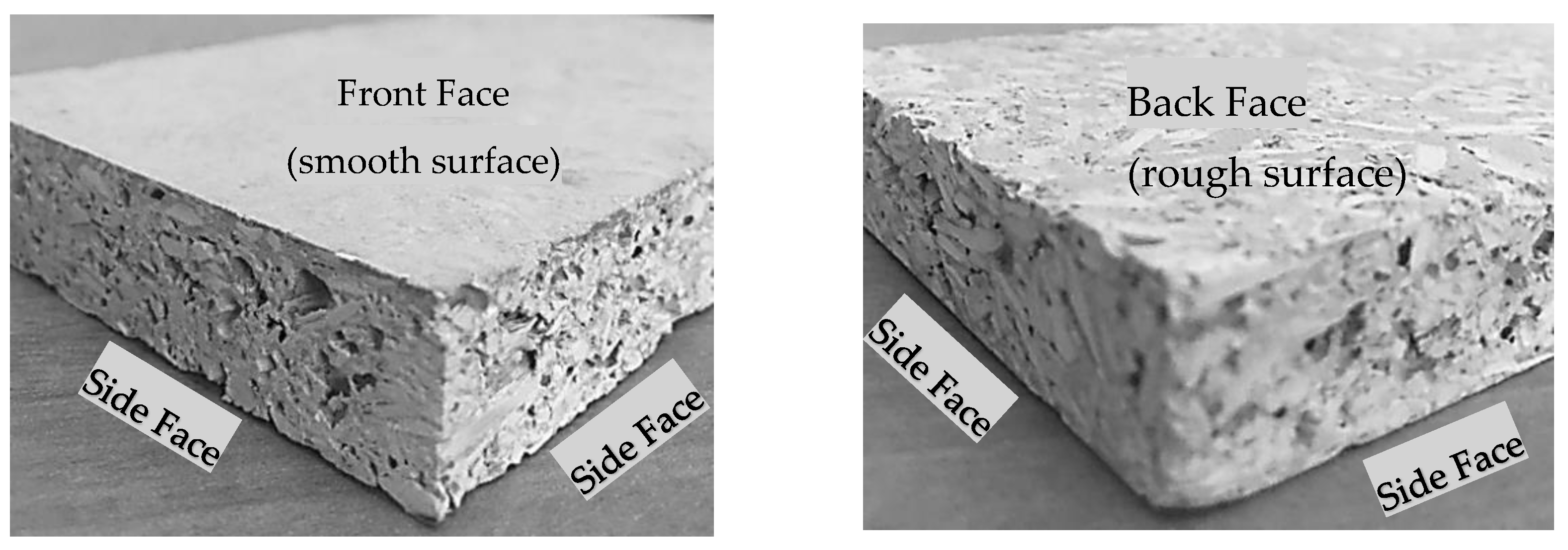
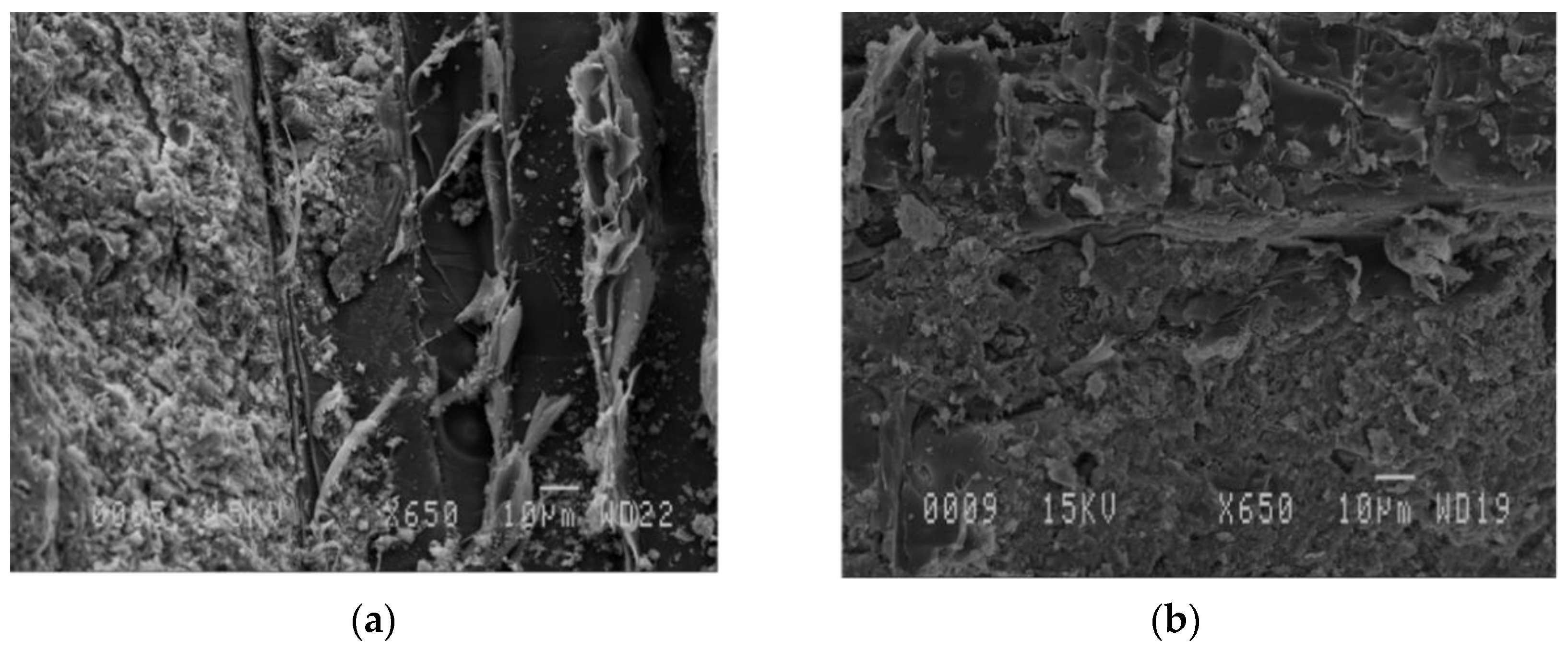
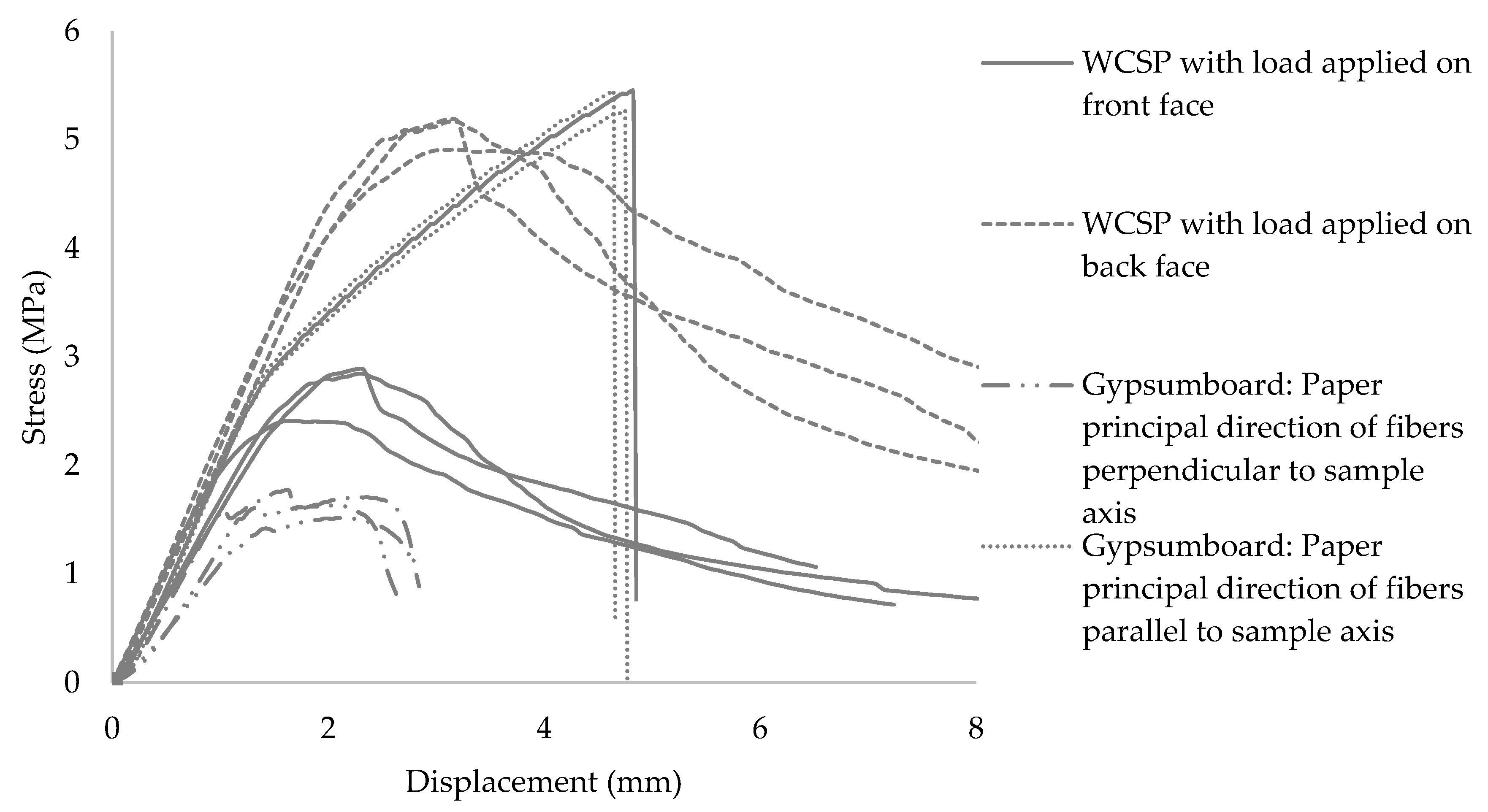

| Chemical Composition (%) | Property | Value | |
|---|---|---|---|
| SiO2 | 38.3 | Density | 2.91 g/cm3 |
| Al2O3 | 0.70 | Blaine fineness | 6505 cm2/g |
| Fe2O3 | 6.32 | pH | 9.4 |
| MgO | 33.9 | ||
| CaO | 0.77 | ||
| Na2O | 0.22 | ||
| K2O | <0.01 | ||
| TiO2 | 0.02 | ||
| MnO | 0.09 | ||
| P2O5 | <0.01 | ||
| Cr2O3 | 0.34 | ||
| V2O5 | <0.01 | ||
| ZrO2 | <0.02 | ||
| ZnO | <0.01 | ||
| PAF | 20.4 | ||
| Step | Mixer Rotor Speed (rpm) | Cumulative Time (s) |
|---|---|---|
| Addition of cement and wood ashes | 140 | 0 |
| Addition of water | 140 | 60 |
| Addition of wood particles | 140 | 120 |
| 285 | 180 | |
| End of mixing | 0 | 270 |
| Mass Ratio | P1 | P2 | P3 | P4 | P5 | P6 | P7 |
|---|---|---|---|---|---|---|---|
| Steatite powder/Cement | 0.00 | 0.10 | 0.15 | 0.20 | 0.30 | 0.40 | 0.50 |
| Wood/(Steatite powder + cement) | 0.35 | 0.35 | 0.35 | 0.35 | 0.35 | 0.35 | 0.35 |
| Water/(Steatite powder + cement) | 1.00 | 1.15 | 1.24 | 1.32 | 1.45 | 1.56 | 1.65 |
| Property | GB | WCSP | |
|---|---|---|---|
| Specific gravity | 0.7 (s = 0.02) | 0.68 (s = 0.2) | |
| Sample parallel to paper fiber direction | MOR (MPa) | 5.4 (s = 0.08) | |
| MOE (GPa) | 1.9 (s = 0.03) | ||
| Sample perpendicular to paper fiber direction | MOR (MPa) | 1.6 (s = 0.08) | |
| MOE (GPa) | 1.3 (s = 0.04) | ||
| Load on front face | MOR (MPa) | 2.7 (s = 0.2) | |
| MOE (GPa) | 1.7 (s = 0.24) | ||
| Load on back face | MOR (MPa) | 5.1 (s = 0.12) | |
| MOE (GPa) | 2.1 (s = 0.09) |
| PROPERTY | GB | WCSP | |
|---|---|---|---|
| Screw withdrawal resistance test (N) | ASTM C473-15 | 374 (s = 8) | 415 (s = 20) |
| Nails pull resistance (N) | ASTM 1037-12 | 328 (s = 7) | 450 (s = 38) |
| Property | GB | WCSP |
|---|---|---|
| Water absorption (%) | 54 | 51 |
| Thickness swelling (%) | 5 | −1 |
| Property | GB | WCSP |
|---|---|---|
| Thermal capacity (kJ/kg·K) | 970 | 1338 |
| Specific heat (kJ/m3·K) | 679 | 910 |
| Thermal conductivity (W/m·K) | 0.32 | 0.12 |
| Property/Characteristic | GB | WCSP |
|---|---|---|
| Average ignition time (s) | 57 | none |
| Average peak rate of heat release (kW/m2) for 15 min | 109.87 | 15.03 |
| Average time to peak rate of heat release (s) | 65 | 423 |
| Average total smoke production (m2) for 15 min | 0.19 | 0.28 |
| Average total heat release (MJ/m2) for 15 min | 5.89 | 7.88 |
Publisher’s Note: MDPI stays neutral with regard to jurisdictional claims in published maps and institutional affiliations. |
© 2020 by the authors. Licensee MDPI, Basel, Switzerland. This article is an open access article distributed under the terms and conditions of the Creative Commons Attribution (CC BY) license (http://creativecommons.org/licenses/by/4.0/).
Share and Cite
Vu, V.-A.; Cloutier, A.; Bissonnette, B.; Blanchet, P.; Dagenais, C. Steatite Powder Additives in Wood-Cement Drywall Particleboards. Materials 2020, 13, 4813. https://doi.org/10.3390/ma13214813
Vu V-A, Cloutier A, Bissonnette B, Blanchet P, Dagenais C. Steatite Powder Additives in Wood-Cement Drywall Particleboards. Materials. 2020; 13(21):4813. https://doi.org/10.3390/ma13214813
Chicago/Turabian StyleVu, Viet-Anh, Alain Cloutier, Benoît Bissonnette, Pierre Blanchet, and Christian Dagenais. 2020. "Steatite Powder Additives in Wood-Cement Drywall Particleboards" Materials 13, no. 21: 4813. https://doi.org/10.3390/ma13214813
APA StyleVu, V.-A., Cloutier, A., Bissonnette, B., Blanchet, P., & Dagenais, C. (2020). Steatite Powder Additives in Wood-Cement Drywall Particleboards. Materials, 13(21), 4813. https://doi.org/10.3390/ma13214813








